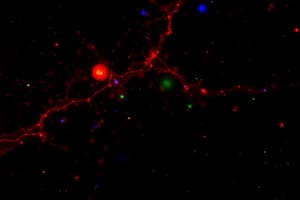Podcast
Questions and Answers
What is fluorescence?
What is fluorescence?
- Reflection of light by any substance
- Emission of light from any substance (correct)
- Scattering of light by any substance
- Absorption of light by any substance
What is the Franck-Condon Principle related to?
What is the Franck-Condon Principle related to?
- Excited-state reactions in a solvent
- Fluorescence intensity versus wavelength plot
- Energetic transition of electrons and nuclei adjustment (correct)
- Complex formation in fluorescence
What is the Stokes shift in fluorescence?
What is the Stokes shift in fluorescence?
- Fluorescence typically occurs at higher energies or shorter wavelengths
- Reflection of light by a substance
- Fluorescence typically occurs at lower energies or longer wavelengths (correct)
- Absorption of light by a substance
What does Kasha’s Rule state about fluorescence spectrum?
What does Kasha’s Rule state about fluorescence spectrum?
What is plotted in a fluorescence emission spectrum?
What is plotted in a fluorescence emission spectrum?
What is the process that takes place fast according to the Franck-Condon Principle?
What is the process that takes place fast according to the Franck-Condon Principle?
What is the term for decay to higher vibrational energy levels of S0?
What is the term for decay to higher vibrational energy levels of S0?
What is fluorescence anisotropy based on?
What is fluorescence anisotropy based on?
What decreases measured anisotropy in fluorescence anisotropy?
What decreases measured anisotropy in fluorescence anisotropy?
What is resonance energy transfer (RET) based on?
What is resonance energy transfer (RET) based on?
What are steady-state fluorescence measurements based on?
What are steady-state fluorescence measurements based on?
What does the Perrin equation describe in fluorescence measurements?
What does the Perrin equation describe in fluorescence measurements?
What is lost in the time averaging process in time-resolved fluorescence?
What is lost in the time averaging process in time-resolved fluorescence?
What does the Förster distance (R0) represent in resonance energy transfer (RET)?
What does the Förster distance (R0) represent in resonance energy transfer (RET)?
What are intrinsic fluorophores?
What are intrinsic fluorophores?
What does fluorescence polarization or anisotropy indicate?
What does fluorescence polarization or anisotropy indicate?
What is the principle of Fluorescence Correlation Spectroscopy (FCS)?
What is the principle of Fluorescence Correlation Spectroscopy (FCS)?
What does Resonance Energy Transfer (RET) involve?
What does Resonance Energy Transfer (RET) involve?
What does Single Molecule Detection (SMD) offer?
What does Single Molecule Detection (SMD) offer?
What do emission spectra of proteins provide?
What do emission spectra of proteins provide?
What is the purpose of biochemical fluorophores?
What is the purpose of biochemical fluorophores?
What is the indication of quenching of fluorescence?
What is the indication of quenching of fluorescence?
What is the basis of Multiphoton Excitation?
What is the basis of Multiphoton Excitation?
What does Kasha’s Rule state?
What does Kasha’s Rule state?
What does the Stern-Volmer equation calculate?
What does the Stern-Volmer equation calculate?
What is the purpose of fluorescence quenching?
What is the purpose of fluorescence quenching?
What does the Franck-Condon principle explain?
What does the Franck-Condon principle explain?
What is fluorescence anisotropy?
What is fluorescence anisotropy?
What do common quenchers include?
What do common quenchers include?
What is the purpose of the Quantum yield?
What is the purpose of the Quantum yield?
Flashcards are hidden until you start studying
Study Notes
Fluorescence Spectroscopy: Key Concepts and Principles
- Fluorophores exist in two ionization states with different absorption and emission spectra
- Kasha’s Rule states that molecules emit from the S2 level
- Symmetry of absorbance and emission spectra results from the same transitions and similar vibrational energy levels
- Quantum yield measures emitted photons relative to absorbed photons, while lifetime determines interaction time
- Fluorescence quenching decreases intensity, with collisional quenching occurring upon contact with other molecules
- Stern-Volmer equation calculates quenching constants and unquenched lifetime based on quencher concentration
- Common quenchers include O2, halogens, amines, and electron-deficient molecules
- Static quenching occurs when fluorophores form nonfluorescent complexes with quenchers
- Quenching provides insight into the role of excited-state lifetime in detecting dynamic processes
- Franck-Condon principle explains rapid absorption and longer emission timescales
- Fluorescence anisotropy is the directional dependence of fluorescence properties
- Anisotropy contrasts with isotropy, which indicates homogeneity in all directions
Studying That Suits You
Use AI to generate personalized quizzes and flashcards to suit your learning preferences.



